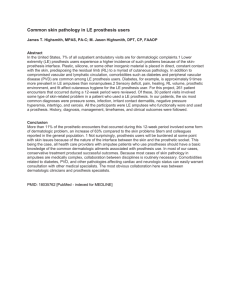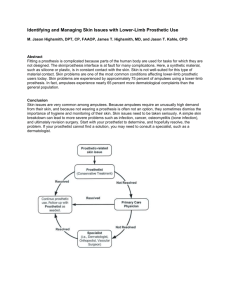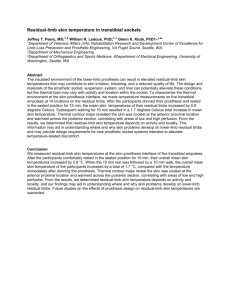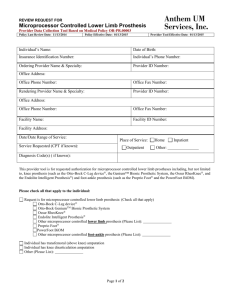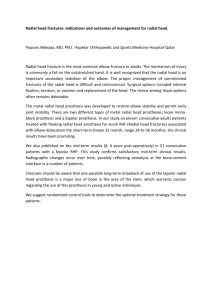Upper Limb Prosthetics
advertisement
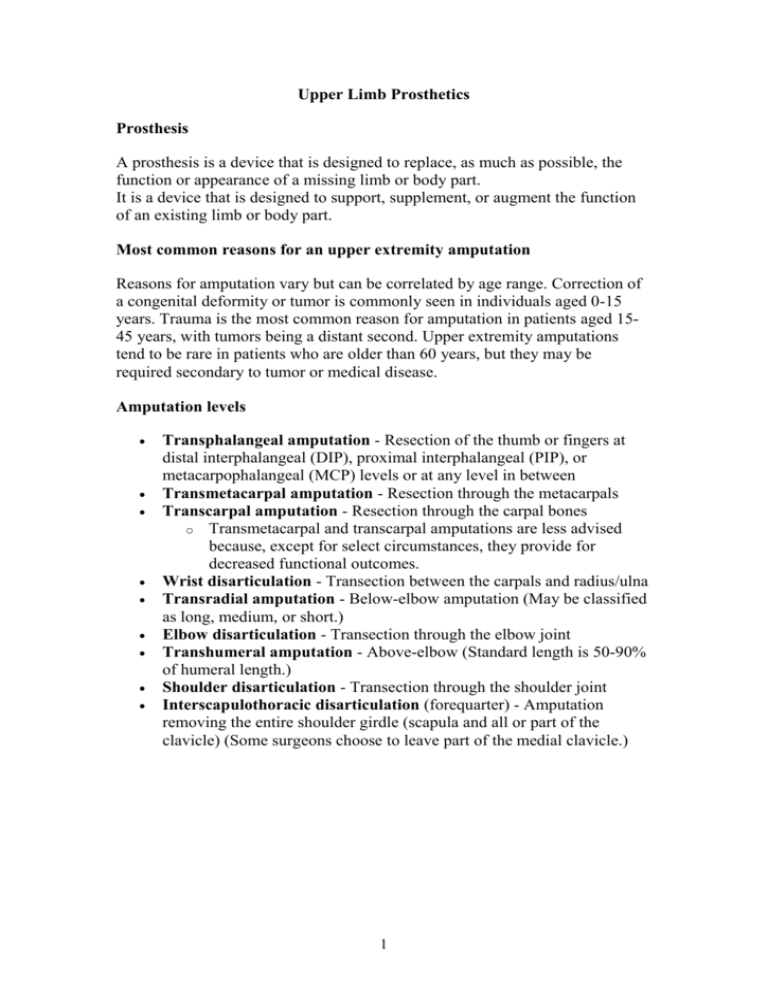
Upper Limb Prosthetics Prosthesis A prosthesis is a device that is designed to replace, as much as possible, the function or appearance of a missing limb or body part. It is a device that is designed to support, supplement, or augment the function of an existing limb or body part. Most common reasons for an upper extremity amputation Reasons for amputation vary but can be correlated by age range. Correction of a congenital deformity or tumor is commonly seen in individuals aged 0-15 years. Trauma is the most common reason for amputation in patients aged 1545 years, with tumors being a distant second. Upper extremity amputations tend to be rare in patients who are older than 60 years, but they may be required secondary to tumor or medical disease. Amputation levels Transphalangeal amputation - Resection of the thumb or fingers at distal interphalangeal (DIP), proximal interphalangeal (PIP), or metacarpophalangeal (MCP) levels or at any level in between Transmetacarpal amputation - Resection through the metacarpals Transcarpal amputation - Resection through the carpal bones o Transmetacarpal and transcarpal amputations are less advised because, except for select circumstances, they provide for decreased functional outcomes. Wrist disarticulation - Transection between the carpals and radius/ulna Transradial amputation - Below-elbow amputation (May be classified as long, medium, or short.) Elbow disarticulation - Transection through the elbow joint Transhumeral amputation - Above-elbow (Standard length is 50-90% of humeral length.) Shoulder disarticulation - Transection through the shoulder joint Interscapulothoracic disarticulation (forequarter) - Amputation removing the entire shoulder girdle (scapula and all or part of the clavicle) (Some surgeons choose to leave part of the medial clavicle.) 1 DIFFERENT TYPES OF PROSTHESES The continuum of prostheses ranges from mostly passive or cosmetic types on one end to primarily functional types on the other. The purpose of most prostheses falls somewhere in the middle. Cosmetic prostheses can look extremely natural, but they often are more difficult to keep clean, can be expensive, and usually sacrifice some function for increased cosmetic appearance. Functional prostheses generally can be divided into the following 2 categories: Body-powered prostheses - Cable controlled Externally powered prostheses - Electrically powered . o Myoelectric prostheses o Switch-controlled prostheses Body-powered prostheses Body-powered prostheses (cables) usually are of moderate cost and weight. They are the most durable prostheses and have higher sensory feedback. However, a body-powered prosthesis is more often less cosmetically pleasing than a myoelectrically controlled type is, and it requires more gross limb movement. Externally powered prostheses Prostheses powered by electric motors may provide more proximal function and greater grip strength, along with improved cosmesis, but they can be heavy and expensive. Patient-controlled batteries and motors are used to operate these prostheses. Currently available designs generally have less sensory feedback and require more maintenance than do body-powered prostheses. Externally powered prostheses require a control system. The two types of commonly available control systems are myoelectric and switch control. A myoelectrically controlled prosthesis uses muscle contractions as a signal to activate the prosthesis. It functions by detecting electrical activity from select residual limb muscles, with surface electrodes used to control electric motors. Different types of myoelectric control systems exist. The 2-site/2-function (dual-site) system has separate electrodes for paired prosthetic activity, such as flexion/extension or pronation/supination. This is more physiologic and easier to control. When limited control sites (muscles) in a residual limb are available to control all of the desired features of the prosthesis, a 1-site/2-function (single-site) device may be used. This system uses 1 electrode to control both functions of a paired activity (for example, flexion and extension). 2 The patient uses muscle contractions of different strengths to differentiate between flexion and extension. For instance, a strong contraction opens the device, and a weak contraction closes it. When multiple powered components on a single prosthesis must be controlled, sequential or multistate controllers can be used, allowing the same electrode pair to control several functions (eg, terminal device, elbow activation). This type of controller requires the control function of the electrodes to be switched from one function to the other. This is accomplished by a brief co-contraction of the muscle or by a switch used to cycle between control-mode functions. Switch-controlled, externally powered prostheses utilize small switches, rather than muscle signals, to operate the electric motors. Typically, these switches are enclosed inside the socket or incorporated into the suspension harness of the prosthesis. A switch can be activated by the movement of a remnant digit or part of a bony prominence against the switch or by a pull on a suspension harness (similar to a movement a patient might make when operating a bodypowered prosthesis). This can be a good option to provide control for external power when myoelectric control sites are not available or when the patient cannot master myoelectric control. Many contemporary myoelectric control systems allow for the use of proportional control so that the speed of the component or terminal device activation varies with the intensity of the muscle contraction. 3 TYPICAL COMPONENTS OF AN UPPER EXTREMITY, BODYPOWERED PROSTHESIS A typical example of a transradial (below-elbow) prosthesis includes a voluntary opening split hook; a friction wrist; a double-walled, plastic-laminate socket; a flexible elbow hinge; a single–control-cable system; a triceps cuff; and a figure-8 harness. A transhumeral (above-elbow) prosthesis is similar but includes an internal-locking elbow with a turntable for the missing anatomic elbow, uses a dual–control-cable system instead of a single-control cable, and does not require a triceps cuff. All conventional body-powered, upper extremity prostheses have the following components: Socket Suspension Control-cable system Terminal device Components for any interposing joints as needed according to the level of amputation Socket The socket of an upper extremity prosthesis typically has a dual-wall design fabricated from lightweight plastic or graphite composite materials. In this design, a rigid inner socket is fabricated to fit the patient's residual limb and the second, outer wall is added, designed to be the same length and contour as the opposite, sound limb. Comfort and function are directly tied to the fit of the inner socket. An alternative approach parallels the rigid frame, flexible liner approach sometimes used in lower extremity socket fabrication. The inner socket is fabricated from flexible plastic materials to provide appropriate contact and fit. Surrounding the flexible liner, a rigid frame is utilized for structural support and for attaching the necessary cables and joints as needed. The windows in the outer socket allow movement, permit relief over bony prominences, and enhance comfort. Suspension The suspension system must hold the prosthesis securely to the residual limb, as well as accommodate and distribute the forces associated with the weight of the prosthesis and any superimposed lifting loads. Suspension systems can be classified as follows: Harnessed-based systems Self-suspending sockets Suction sockets 4 Harnessed-based systems and their variants are the most commonly used systems. For the figure-8 strap, a harness loops around the axilla on the sound side. This anchors the harness and provides the counterforce for suspension and control-cable forces. On the prosthetic side, the anterior (superior) strap carries the major suspending forces to the prosthesis by attaching directly to the socket in a transhumeral prosthesis or indirectly to a transradial socket through an intermediate Y-strap and triceps cuff. The posterior (inferior) strap on the prosthetic side attaches to the control cable. For heavier lifting or as an alternative to the figure-8 harness, a shoulder saddle with a chest-strap suspension can be used with a transradial prosthesis. A chest strap alone is sometimes used to suspend a transhumeral prosthesis. The figure-9 harness is an alternative for a patient with a long transradial amputation or a wrist disarticulation, in order to provide the control harness provides minimal suspension and requires a self-suspending socket, it is more comfortable than a figure-8 harness. Self-suspending and suction sockets are capable of providing adequate prosthetic suspension without the use of a harness. However, either design can also be used with a harness suspension to provide for a more secure suspension of the prosthesis. Self-suspending sockets are largely limited to wrist or elbow disarticulations and to transradial amputations. This socket design is most commonly utilized with an externally powered, myoelectrically controlled transradial prosthesis. An example of this type is the Munster socket. Proper fit of this socket precludes full elbow extension. Suction suspension is similar to lower extremity options. These sockets use an external, elastic suspension sleeve; a one-way air valve; or roll-on gel suspension liner with a pin-locking mechanism. Upper limb suction sockets (unlike nonsuction sockets) require a total contact socket design and ideally a residual limb with no skin invagination, scarring, and stable volume to avoid skin problems, such as a choke syndrome. Suction socket designs are most commonly used for the patient with a transhumeral amputation. 5 Control-cable mechanisms Body-powered prosthetic limbs use cables to link movements of 1 part of the body to the prosthesis in order to control a prosthetic function. This usually is a movement of the humerus, shoulder, or chest, which is transferred via a Bowden cable (a single cable passing through a single housing) to activate the terminal device of the prosthesis. A control cable used to activate a single prosthetic component or function is called a single-control cable, or Bowden cable system. A dual–control-cable system uses the same cable to control 2 prosthetic functions (such as flexion of the elbow and, when the elbow is locked, activation of the terminal device). This latter control cable setup is accomplished with a single cable passing through two separate cable. Body movements that are captured for prosthetic control Glenohumeral forward flexion - A natural movement that provides excellent power and reach and that can activate the terminal device or flex an elbow joint; it is good for activities away from midline. Biscapular abduction (chest expansion), mutual protraction - A movement that can activate the terminal device; however, the device must stay relatively stationary and the force generated is weak. This movement is easy for the amputee to do. It is good for fine motor activities that are performed near the midline or close to the trunk of the body. Shoulder protraction can occur on just the ipsilateral side for terminal-device control without biscapular abduction (mutual protraction) for prosthetic control. Chest expansion results in biscapular abduction without actual protraction. Glenohumeral depression/elevation, extension, abduction - Other body movements that the amputee can utilize to control prosthetic components/function; these movements are most frequently used simultaneously, in a maneuver to lock or unlock an elbow for a patient with a transhumeral amputation, via a separate, anterior cable in a dualcable system. This maneuver can be difficult to master. The use of a waist belt or groin loop allows the amputee to employ scapular elevation as an alternative motion, one that operates a prosthetic function by utilizing a cable that has been run through a pulley. Nudge control – Less cosmetic-appearing action; however, nudgecontrol devices and similhousings known as a fair lead cable system.are types of systems are sometimes invaluable, offering cable-control options for more complex cases where many control functions are needed. 6 TERMINAL DEVICE The major function of the hand that a prosthesis tries to replicate is grip (prehension). The 5 different types of grips are as follows: Precision grip (i.e., pincher grip) - The pad of the thumb and index finger are in opposition to pick up or pinch a small object (e.g., a small bead, pencil, grain of rice). Tripod grip (i.e., palmar grip, 3-jaw chuck pinch) - The pad of the thumb is against the pads of the index and middle finger. Lateral grip (i.e., key pinch) - The pad of the thumb is in opposition to the lateral aspect of the index finger to manipulate a small object (such as turning a key in a lock). Hook power grip - The distal interphalangeal joint and proximal interphalangeal joint are flexed with the thumb extended (as when carrying a briefcase by the handle). Spherical grip - Tips of the fingers and thumb are flexed (when, for example, screwing in a light bulb or opening a doorknob). Terminal devices generally are broken down into 2 categories: passive and active. Passive terminal devices Passive terminal devices fall into two classes, those designed primarily for function and those to provide cosmesis. Examples of the functional passive terminal devices include the child mitt frequently used on an infant's first prosthesis to facilitate crawling or the ball handling terminal devices used by older children and adults for ball sports. The main advantage of most passive terminal devices is their cosmetic appearance. With newer advances in materials and design, some passive hands are virtually indistinguishable from the native hand. However, most of these cosmetic passive terminal devices usually are less functional and more expensive than active terminal devices. Active terminal devices Active terminal devices usually are more functional than cosmetic; however, in the near future, active devices that are equally cosmetic and functional may be available. Active devices can be broken down into 2 main categories: hook (and similarly specialized function) terminal devices and prosthetic hands. There are designs of both of these terminal device groups available to operate with cable or externally powered prostheses. Cable-operated terminal devices (hooks or hands) can be of a voluntary opening design (most commonly used) or a voluntary closing design. Voluntary opening mechanism - With a voluntary opening mechanism, the terminal device is closed at rest. The patient uses the control-cable 7 motion to open the terminal device against the resistive force of rubber bands (hook) or internal springs or cables (hand). Relaxation of the proximal muscles allows the terminal device to close around the desired object. The number of rubber bands determines the amount of prehensile force that is generated. One rubber band provides about 1 pound of pinch force (typical nonamputee pinch force is 15-20 lb). Up to 10 rubber bands can be used Voluntary closing mechanism - With a voluntary closing mechanism, the terminal device is open at rest. The patient uses the control-cable motion to close the terminal device, grasping the desired object. This type of mechanism usually is heavier and less durable than a voluntary opening mechanism. It offers better control of closing pressure (up to 20-25 lb) and is more physiologic, but active effort may be needed to maintain closure for some terminal devices to prevent dropping items. Because of the need to maintain an active muscle contraction for terminal device closure, the amputee can get some sensory feedback with this type of terminal device. A prosthetic hand usually is bulkier and heavier than a hook, but it is more cosmetically pleasing. A prosthetic hand can be powered by a cable or utilize external power. With a myoelectrically controlled device, it is possible for the patient to initiate palmar tip grasp by contracting residual forearm flexors and to release by contracting residual extensors. Most hook-style terminal devices provide the equivalent of active lateral pinch grip, while active hands provide a 3-point chuck action. Many different options are available for terminal devices that address occupations, hobbies, and sports. Many specialized terminal-device designs are available or are custom fabricated by prosthetists to meet the unique functional requirements of individual amputees. Most of the commercially available specialized terminal devices are designed for various recreational and hobby activities. There are terminal devices available for specific activities, such as golfing, bowling, swimming, tennis, weight lifting, fishing, skiing, shooting pool, rock climbing, baseball, hunting (bow and rifle), photography, and the playing of musical instruments (guitars and drums). 8 WRIST, ELBOW, SHOULDER, AND FOREQUARTER UNITS COSMETIC FUNCTIONAL CABLE-ACTIVATED TERMINAL DEVICES MYOELECTRICALLY CONTROLLED Wrist units The wrist unit provides orientation of the terminal device in space. It can be positioned manually, by cable operation, or with external power (whether myoelectrically or by switch). Once positioned, the wrist unit is held in place by a friction lock or a mechanical lock. Several different unit designs are available, including a quick-disconnect unit, a locking unit, and a flexion unit. Friction-control wrist units are easy to position but can slip easily when carrying heavier loads. Quick-disconnect wrist unit This style is configured to allow easy swapping of terminal devices that have specialized functions. Locking wrist unit Wrist units with a locking capacity prevent rotation during grasping and lifting. Wrist flexion unit A wrist flexion unit can provide an amputee (especially a bilateral upper extremity amputee) with improved function for midline activities, such as shaving, manipulating buttons, or performing perineal care. A flexion wrist unit usually is employed on only one side, most often the longer of the two residual 9 limbs, but ultimately it should be placed on the side that the amputee prefers. Multifunction wrist units have become available. Elbow units Elbow units are chosen based on the level of the amputation and the amount of residual function. It is helpful to remember that supination and pronation of the forearm decrease as the site of amputation becomes more proximal. Flexible elbow hinge Flexible elbow hinges are utilized for medium and long transradial amputations and wrist disarticulations. When the patient has sufficient voluntary pronation and supination, as well as elbow flexion and extension, flexible elbow hinges help translate any residual active pronation and supination to the terminal device. A triceps pad or cuff helps distribute suspension forces and is needed to anchor the control cable. Rigid elbow hinge With short transradial amputations, a patient has no residual, active forearm pronation and supination but does have adequate native elbow flexion. Rigid elbow hinges provide additional stability. Hinges are available in single-axis or polycentric versions. Rigid hinges are important in amputees with short transradial limbs. In patients with very short transradial, residual limbs or limited active elbow flexion, the use of step-up elbow hinges can improve prosthetic function by increasing functional, active elbow motion. This system uses special elbow joints together with a split-socket design permitting the prosthetic forearm and attached terminal device to move 2º of motion for every 1º of actual residual limb and elbow motion. Since movement of the limb and the prosthesis are not directly connected, the proprioceptive feedback is compromised. Internal elbow The standard elbow component for a transhumeral prosthesis is an internal locking elbow joint. This allows for 135º of flexion and can be locked into a number of preset flexed positions. The standard internal elbow joint incorporates a turntable that allows passive internal or external humeral rotation. Elbow spring-lift assists are available and are used to counterbalance the weight of the forearm, making elbow flexion easier. The standard elbow unit requires a length of 8-10 cm to be adequately installed in a transhumeral prosthesis. If the level of amputation is less than 8-10 cm proximal to the distal end of the humerus, then an internal locking elbow unit cannot provide symmetric elbow centers (prosthesis and sound upper extremity). Even if an asymmetric elbow position (compared with the sound 10 side) is acceptable, functional problems will result with the prosthesis from this alignment. Unless the forearm section of the prosthesis is lengthened to accommodate the lengthened arm section, the amputee will not be able to reach the midline or mouth, with the prosthesis compromising function. However, lengthening the forearm to accommodate the added arm length will result in difficulties when the patient tries to perform bimanual activities, and it usually will not be cosmetically acceptable to the patient. For long transhumeral amputations or elbow disarticulations, locking external elbowjointsmay be used, but they are not cosmetic or as durable as internal elbow joints. Shoulder and forequarter units When an amputation is required at the shoulder or forequarter level, function is very difficult to restore. This is due to a combination of the weight of the prosthetic components and the diminished overall function when combining multiple prosthetic joints, as well as the increased energy expenditure necessary to operate the prosthesis. For this reason, some individuals with a unilateral amputation at this level choose a purely cosmetic prosthesis to improve body image and the fit of their clothes or decide to go without a prosthesis. 11
